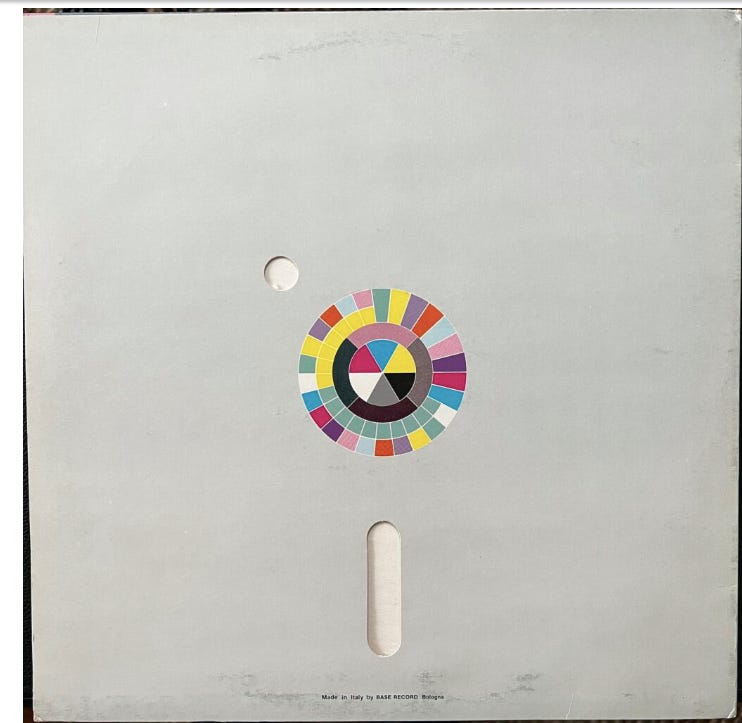Secret codes! How many of used some kind of secret decoder as a kid, whether from a Cracker Jack box, or a magazine puzzle, or a secret system between friends? If you are like me, they never get old. But – despite having been a fan of Joy Division and early New Order since I was in my teens - it turns out though that all this time I was NOT in the cool kids tent. Yes, Factory Records fans, I was today years old when I learned about Peter Saville’s Color Cypher. Cringe.
It all started with me walking into a Corridor store in Fort Greene Brooklyn, wearing a shirt with this classic New Order album cover:
“Cool shirt,” the salesperson called out.
“Peter Saville and New Order, you like?” I replied.
“Yeah,” he said. “That’s the original New Order Power Corruption and Lies cover, no lettered title. Just his Color Cypher secret code.”
His what?
As soon as I got home, I dove into the rabbit hole of Saville’s Color Cypher. If you happen to be hearing about this for the first time, or are instead incredulously asking how could you have not known about this all along, I’ve hopefully done the back story and explanation some justice. Read on.
How to Make The Best Selling 12 Inch Single of All Time – And Still Lose Money
Even if “Blue Monday” isn’t a familiar song title, you’ve probably heard the opening drum machine line: two opening bass drum beats, followed by a rapid, stuttering, obviously computerized series of bass drum beats in alternating 4/4 bars. Less familiar to most, but essential to the New Order fan, is the original cover for the 12 inch single.
Peter Saville, the iconic British graphic designer behind some of the most visually striking record covers of the 20th century, has never shied away from abstraction. Saville’s sleeve for “Blue Monday” was made to resemble a 5.25-inch floppy disk, referencing the song’s innovative, electronic sound and the emerging digital age. It had no text—no band name, no track title, nothing to suggest what it contained. Just a minimalist cut-out design, with a die-cut edge, and a futuristic but out of place color control patch strip on the spine that seemed to bear no relation to the otherwise black cover. See the sticker on the cover? That was necessary for nearly any human to know what this artifact was all about. But Saville doggedly explained that the design aimed to“make a record cover for the future, a statement of digital culture.”
Factory Records – the label under which New Order operated – became famous for creatively losing money under the most favorable conditions, concluding in its 1992 bankruptcy. Best selling 12 inch of all time? New Order’s Blue Monday, under Factory Records. And while the album sleeve was one of the most celebrated designs of all time, the die-cut sleeve was expensive to produce. So expensive, in fact, that Factory Records reportedly lost money on every copy sold.
Power, Corruption & Lies…And Also, Cyphers
Along with the 1983 release of the Blue Monday single, New Order released a full LP: Power, Corruption & Lies, featuring another Saville-designed album cover. Saville once again went heavily cryptic, choosing a reproduction of a 19th-century still life painting—Henri Fantin-Latour’s "A Basket of Roses"—sourced from a postcard he found at the National Gallery in London. And, in addition to a similar color control patch strip on the front, the rear cover featured an entire color-wheel like design that seemed to celebrate the technicality of color proofing:
This, as it turns out, is where the story paused for me – in fact for over 40 years. I’d always assumed that these color test patterns on the side of the albums was simply a nod to commercial graphic design, and nothing more. To be fair – I grew up middle class suburban in Tucson Arizona, where the majority of kids would be interested in cars, heavy metal music, guns, and lowbrow humor. And even though I was part of the gloomy, dressed-in-black minority that twirled to alternative music at the Fineline, this was years before the Internet. And, few if any of us had any connection into the highbrow design scene of New York, London, or Paris…not to mention Manchester England. The closest we’d come would be Burning Airlines, or a fan newsletter.
But with the release of Power, Corruption & Lies, Saville had now introduced his Color Cypher. Someone paying closer attention would have noticed the inconsistent segmentation of the wheel – some sections with three concentric bands, other with two. And a total of 26 segments. Why 26? With a little patience, and a keen power of observation, the following reference would have eventually come into focus:
Each color segment corresponds to a specific letter or number, creating a coded visual language.
It’s a direct confrontation of the idea that design must be immediately legible or functional. Instead, Saville challenges viewers to engage actively, to "read" the image with both their eyes and intellect.This method of encoding meaning reflected Saville’s long-standing interest in systems of communication and the relationship between content and form. In 1983, when far less competed for our attention, it was just a fun cryptograph. But it’s aged well, and into something far more relevant and meaningful. Saville’s work now makes a statement about our overexposure to information and imagery. In a media-saturated world where visuals often scream for attention, Saville’s Color Cypher whispers, requiring patience, curiosity, and context. It’s even a sharp critique of the instant-gratification culture, asking: What do we miss when we only skim the surface? How do we find signal in all of the noise? How do we see something that’s been hiding in plain sight?
For all of you fans of New Order, Joy Division, Factory Records, and Saville: was this your first revelation of the Color Cypher? If not, when was it? How did you come across it? Share your story in the comments!
Michael Thompson as Information for Humans helps companies create reliable, understandable information. With nearly 30 years of experience as an effective project and team manager, he is a seasoned provider of quality information controls, governance, and presentation for clients and the broader community.
You can reach him at michael@informationforhumans.com and you can find his practice at








